Orchids make beautiful and interesting houseplants. They are not as finicky or as difficult to grow as their reputation might suggest. After all, there are nearly 1,000 genera and more than 100,000 species of orchids to choose from and those that make their way into garden centers or supermarkets are there because they are, in fact, easy to grow.
Orchid growing success–like growing almost any plant–is simply linked to giving the orchid the best opportunity to thrive, and orchids more than anything want to thrive. The key to succeeding as an orchid grower is giving the plant the soil, light, temperature, water, and food.
Use this guide to get shop for and start growing orchids.
Purchasing an orchid
When you go to purchase an orchid, look or the following:
- A plant that is in proportion to its container; not too big, not too small.
- Roots well anchored in the soil or growing media.
- Leaves that are unblemished, medium green color, an free of insect pests.
- Lustrous flowers free of spots and well-supported on the stem or spike.
- Some flower buds that have not yet opened.
Growing your orchid
Here are 12 orchids you can grow as houseplants and their special needs. Use the links in each section to learn more about your favorite orchids.
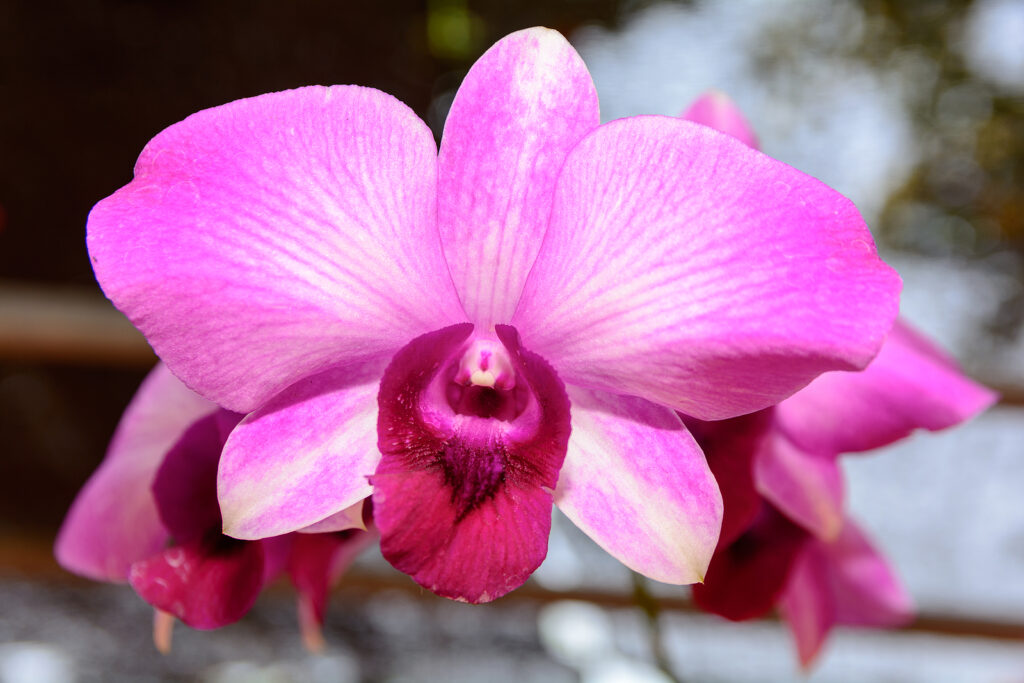
Cattleya
Cattleya are epiphytic (tree-dwelling) orchids native to tropical America. They are relatively easy to grow and suitable for beginners. Cattleya are the most popular and widely grown of all orchids. Cattleya includes the corsage blossom. There are many Cattleya species, varieties, and hybrids. Hybrid forms include miniatures and bifoliates (standard-sized plants with leaves in pairs). See How to Grow Cattleya
- Size: Cattleyas range in height from a few inches to more than 24 to 26 inches (60-66cm) tall.
- Flowers and foliage: Cattleyas produces 3 to 5-inch (7.6-12cm) flowers; 2 to 6 flowers per stem. Flowers last for 10 to 25 days. Flowers appear in shades of lavender, purple, white, yellow, orange, red, green, and bronze. Many bloom more than once a year. Cattleyas have pseudobulbs; these bear leathery leaves.
- Soil: Grow Cattleya in osmunda fiber, fir bark, or orchid bark mix .
- Light indoors: Grow Cattleya in bright light from a southern exposure. Does well under artificial light, need 12 to 16 light hours each day.
- Temperature: Optimal growing temperature: day 65° to 75°F (8° to 24°C), night 55° to 60°F (13° to 16°C) or in an intermediate to warm greenhouse.
- Water: Cattleya likes moisture. Let the soil dry out thoroughly between waterings. Water more often in summer than in winter.
- Feeding: Use a mild fertilizer, such as 10-10-5. Cattleyas growing in fir bark require extra nitrogen than those grown in osmunda fiber. Apply a quarter-strength fertilizer solution at every watering. Do not fertilize in winter.
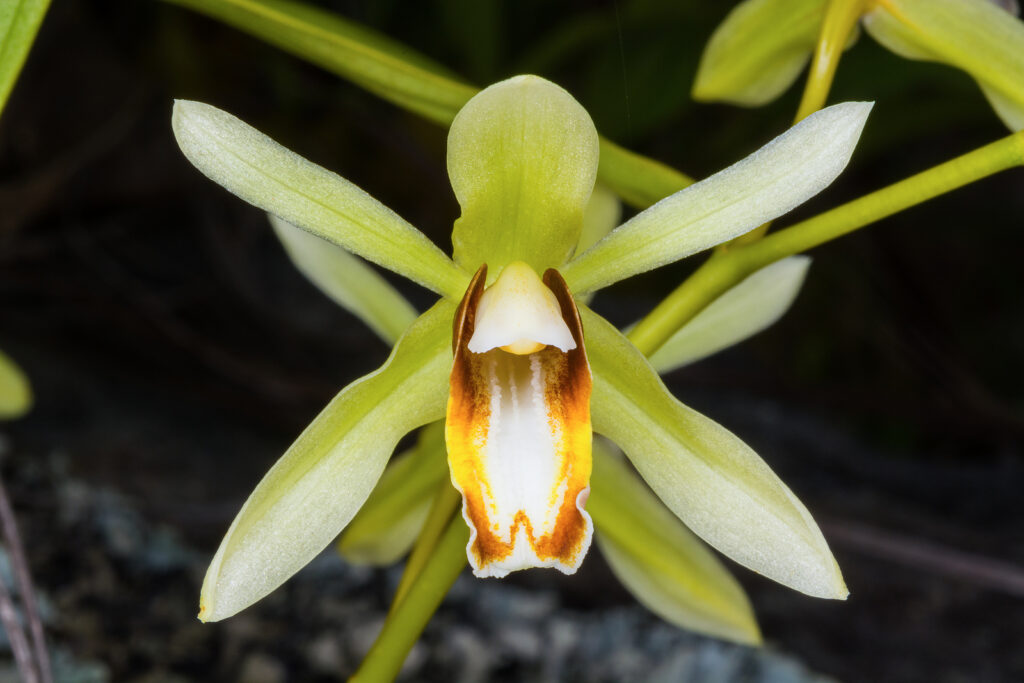
Coelogyne
Coelogyne is a genus of orchids found through Southeast Asia and on some Pacific Highlands. Some Coelogyne species are native to the Himalayas; they do not require warm tropical temperatures to grow well. Coelogyne flowers range in size from small to large and showy, depending on the species. Flowers are commonly white, tan, or green in color. Some are fragrant and most are long-lasting. Because many species do not need tropical temperatures, they can be grown in the average home and can survive with minimal attention. See How to Grow Coelogyne
- Size: Coelogyne ranges in height from 10 to 12 inches (25-30cm)..
- Flowers and foliage: Produces dark green, spoon-shaped leaves and small flowers in shades of brown, cream, beige, or green. Flowers are 1½ to 4 inches (4-10cm) across, 5 to 12 flowers per stem. Flowers last from 10 to 21 days.
- Soil: Grow Coelogyne in osmunda fiber, fir bark, or orchid bark mix .
- Light indoors: Grow Coelogyne in a shaded low-light locations.
- Temperarture: Coelogyne prefers cool temperatures. Optimal growing temeratures: day 60° to 70°°F (16° to 21°C), night 50° to 55°F (10° to 13°C) or in a cool to intermediate greenhouse.
- Water: Coelogyne wants abundant water during the growing season (early spring through early summer). Do not let excess water collect in new growth where flower buds form, since it may cause them to rot.
- Feeding: Give Coelogyne a balanced fertilizer mixed at one-quarter strength to one-half of the recommended strength once a week during growth period. Use a fertilizer lower in nitrogen and higher in phosphorus during the late summer and fall to promote better blooming the next season.
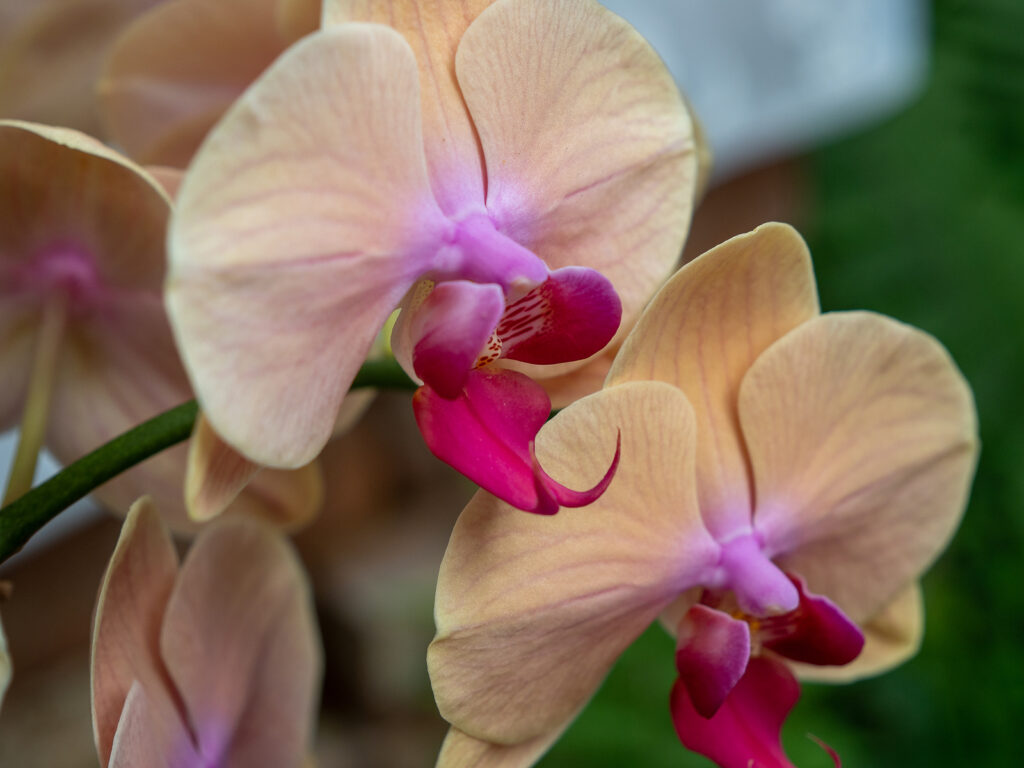
Cymbidium
Cymbidiums are popular and widely grown orchids that produce handsome, waxy flowers. The blooms are long-lasting even when cut, staying attractive as long as two or three months. There are thousands of Cymbidium hybrids derived from about 40 species in the genus. Cymbidiums may be terrestrial or epiphytic. They grow from pseudobulbs and are native to high-altitude regions in Southeast Asia where rainfall is heavy and nights are cool. See How to Grow Cymbidium
- Size: Cymbidium grows 48 to 60 inches (1.2-1.5m) tall. Miniature species and hybrids grow 12 to 18 inches (30-48cm) tall.
- Flowers and foliage: Long, narrow, grasslike leaves form a sheath around stout oval pseudobulbs. Long-lasting flowers blossom on erect or arching spikes, usually from late winter to early spring. Some hybrids may bloom earlier or later. Large-flowered forms bear 12 to 24 flowers that are 4 ½ to 5-inches across. Large-flowered varieties have white, pink, yellow, green, or bronze flowers. On the throat of most, yellow and dark red markings highlight the lip of the bloom. Miniature forms are about one-quarter the size of the standard types; they are abundant bloomers. Flowers last from 50 to 60 days
- Soil: Grow Cattleya in osmunda fiber or orchid bark mix.
- Light indoors: Bright light from a northern exposure or full southern exposure indoors in winter. Needs lots of light to flower but should be protected from the intense summer sun. Once buds begin to swell, decrease the amount of light to prevent bud drop.
- Temperarture: Optimal growing temperature: day 75° to 80°F (24° to 27°C), night 45° to 50°F (7° to 10°C) or in a cool to intermediate greenhouse.
- Water: Water freely during the growing period but let the growing medium dry slightly between waterings. Mist frequently. Humidity of 40% to 50% is optimal.
- Feeding: Fertilize with an all-purpose fertilizer with each watering during the active growing period. Feed miniature hybrids only every 3 weeks during the active growing period.

Dendrobium
Dendrobiums are mostly epiphytic orchids cultivated for their delicate and attractive flowers that appear in an array of pastel colors. Blooms occur along the full length of an arching stem in some species, or in sprays emanating from the apex of the stem in others. Some Dendrobiums are deciduous and lose all of their leaves before flowering–they flower on leafless stalks, other varieties are evergreen and retain their leaves year-round. Some Dendrobium blossoms last only a week, others stay in bloom for several months. Dendrobium species are among the easiest orchids to grow and bring to flower. See How to Grow Dendrobium
- Size: Dendrobium grows 8 to 10 inches (20-25cm) tall.
- Flowers and foliage: Some Dendrobium species have small, pale flowers; others have large, showy ones. The flowers are borne in groups, or on arching spikes. Flower spikes emerge from bulblike pseudobulbs (swollen stems) or from reedlike stems.
- Soil: Grow Dendrobium in osmunda fiber or orchid bark.
- Light indoors: Dendrobium wants bright light form a southern exposure. Give it shade from direct sun in summer. Smaller plants to well under atricificial light, needing 12 to 16 light-hours each day.
- Temperature: Optimal growing temperature: day 70° to 80°F (21° to 27°C), night 60°F (16°C) for evergreen varieties and 55° to 60°F (12° to 16°C) for deciduous varieties. Or grow Dendrobiums in an intermediate to warm greenhouse.
- Water: Water freely but let the growing medium become almost dry between waterings.
- Feeding: Feed decidious plants monthly during active growth with an all-purpose orchid fertilier. Feed evergreen varieties twice a month during active growth with an all-purpose orchid fertilizer.
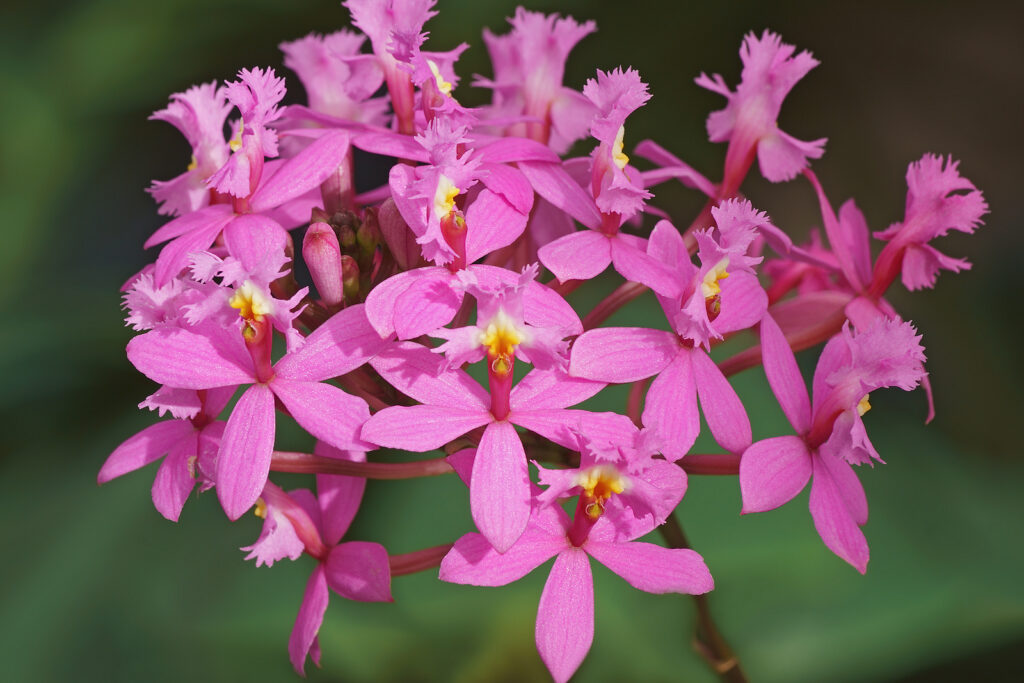
Epidendrum –Buttonhole orchid
Epidendrum is a very large genus of mostly epiphytic and some terrestrial orchids native to the southeastern United States and tropical Americas. Epidendrums have colorful flowers borne on terminal spikes. Some grow from pseudobulbs and others are cane-stemmed. Epidendrums are tough plants and easy to care for. They grow well and once settled to a spot indoors will bloom every few months with blooms lasting for several weeks. See How to Grow Epidendrum
- Size: Bublous types grows 20 inches (50cm) tall; reed stemmed types grow 24 to 60 inches (61cm-1.5m) tall.
- Flowers and foliage: Flowers on bulbous forms grows 1½ to 4 inches (4-10cm) across; there are 10 to 30 flowers per stem and flowers bloom for 10 to 40 days. Flowers on reed stemmed types grow 1½ inches across; dozens of flowers appear in succession and flowers last 8 to 10 days.
- Soil: Grow Epodendrum in osmunda fiber or orchid bark mix .
- Light indoors: Plants with pseudobulbs require brigjhyt light from a southern exposure; shade form summer sun at midday. Plants with canelike stems lacking pseudobulbs require slight more shade. Smaller plants do well under artificial ligt, need 12 to 16 light hour daily.
- Temperarture: Optimal growing temperature: day 75° to 80°F (24° to 27°C), night 60° to 65°F (16° to 18°C) or in an intermediate to warm greenhouse.
- Water: Allow plants with pseudobulbs to become nearly dry between waterings. Plants with canelike stems should be kept moist, not wet, year round. Mist foliage often. Optimal humidity is 50%.
- Feeding: Feed Edidendrum twice a month during active growth with all-purpose fertilizer.
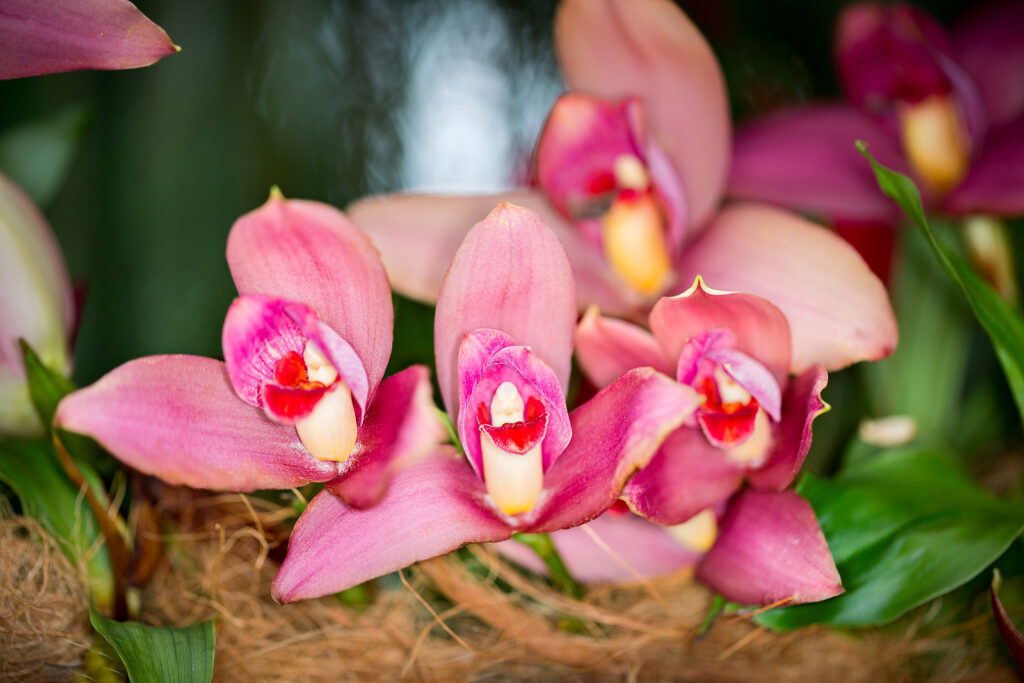
Lycaste
Lycaste are epiphytic and terrestrial orchids with large colorful flowers, some smell like cinnamon. Lycaste petals are typically yellow, white, or orange and the sepals are yellow, orange, green, or reddish-brown. The petals and sepals may be marked sparsely or densely with red, reddish-purple, purple, or reddish-brown spots. Lycaste are native to Central America. There are about 30 species in the genus, Many are easily grown on a windowsill. See How to Grow Lycaste
- Size: Lycaste grows to about 18 inches (45cm) tall.
- Flowers and foliage: Epiphytic types have large pseudobulbs that produce one to three pleated-looking leaves. Long-lasting flowers are usually green, but some turn out in shades of pink, white, yellow, or brown.
- Soil: Plant Lycaste in fast-draining orchid soil mix.
- Light indoors: Lycaste prefers bright reflected light, no direct sun. Grow deciduous species in bright light from a southern exposure. Does well under artificial light, need 12 to 16 light hours each day. Evergreen species can be grown with less light.
- Temperarture: Lycaste wants cool temperatures: day 60° to 70°F (16° to 21°C ), night 50° to 55°F (10° to 13°C) at night.
- Water: Keep the soil constantly moist, except for the 2-week period after flowering. After flowering, keep soil barely moist until new growth appears. Lycaste prefers high humidity; grow it on a humidity tray. Maintain humidity at betewwn 40 and 70 percent.
- Feeding: Lycaste needs regular heavy feeding when it is actively growing. Use a high nitrogen formulation such as 30-10-10 through the summer. In autumn swtich to a high-phosphorus formulation such as 10-30-20 to stimulate flower production
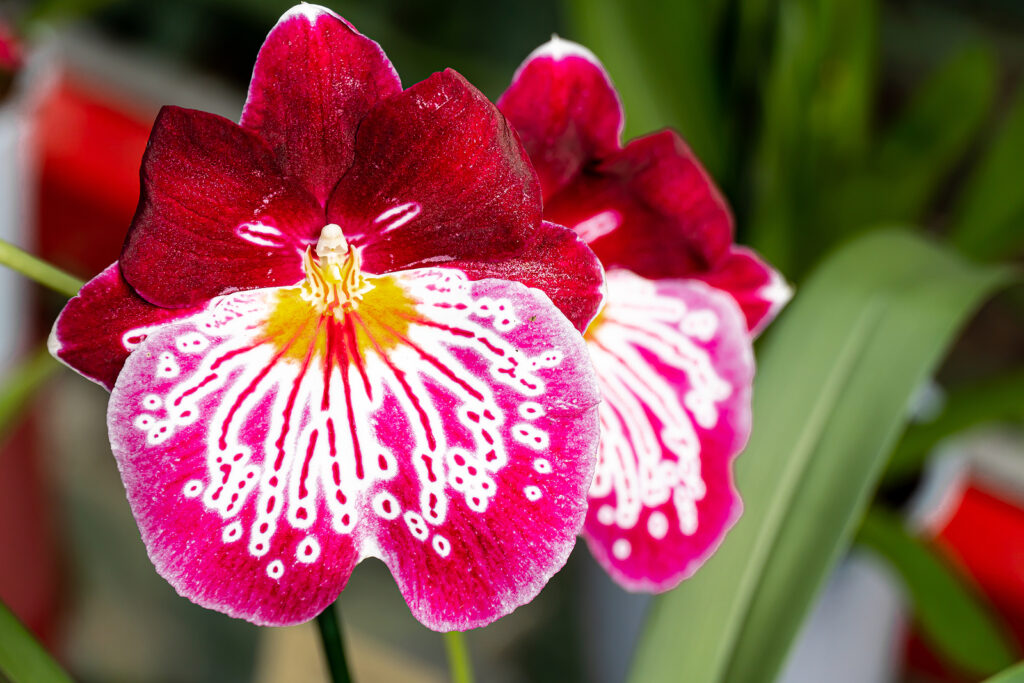
Miltonia — Pansy orchid
Miltonia are epiphytic orchids sometimes called the “Pansy Orchid” because they resemble pansies or violas. Miltonia orchids have slim arching stems, vibrant colors varying from bright reds, pink, white with tinted spotting, to a variety of yellows. Miltonia usually have a very short bloom time. The Miltonia genus is split into two distinct genera: warmer growing orchids native to Brazil, and cooler growing orchids from Columbia, Costa Rica, and Panama that are commonly referred to as Miltoniopsis. Miltonia and Miltonopsis species can be difficult to grow, but many hybrids are relatively easy to grow. See How to Grow Miltonia
- Size: Miltonia grows 12 to 18 inches (30-45cm) tall.
- Flowers and foliage: Flat, velvety flowers borne singly or in clusters resemble pansies are 2 to 5 inches across. Five to seven flowers appear on each stem. Flowers last from 10 to 28 days. Colors include whites, yellows, reds, and blends of these hues. Flowers are sometimes spotted or patterned. Some Miltonia blossoms have a spicy-sweet fragrance. Produces graceful, pale green, bladelike leaves, borne from short pseudobulbs; forms a clump of foliage 10 to 12 inches tall and just as wide.
- Soil: Pot Miltonia in a small orchid bark that retains moisture.
- Light indoors: Colombian and Panamanian species and their hybrids prefer bright filtered or dappled sun, but no direct sunlight. Brazilian species and hybrids prfer sun; give them a western or southern exposure, as you would a Cattleya.
- Temperarture: Miltonias require fairly cool nights to flower, 55° to 60°F (13° to 16°C) are best. Keep daytime temperatures below 80°F (27°C). Best in a intermediate to warm greenhouse.
- Water: While flower spikes are forming, keep the soil moist (like a squeezed-out sponge), but not soggy. Water Miltonia less frequently during the winter, letting the soil dry out somewhat between waterings. Place Miltonia on a humidity tray for best growth.
- Feeding: Fertilize Miltonia monthly during the growing season, but not in winter.
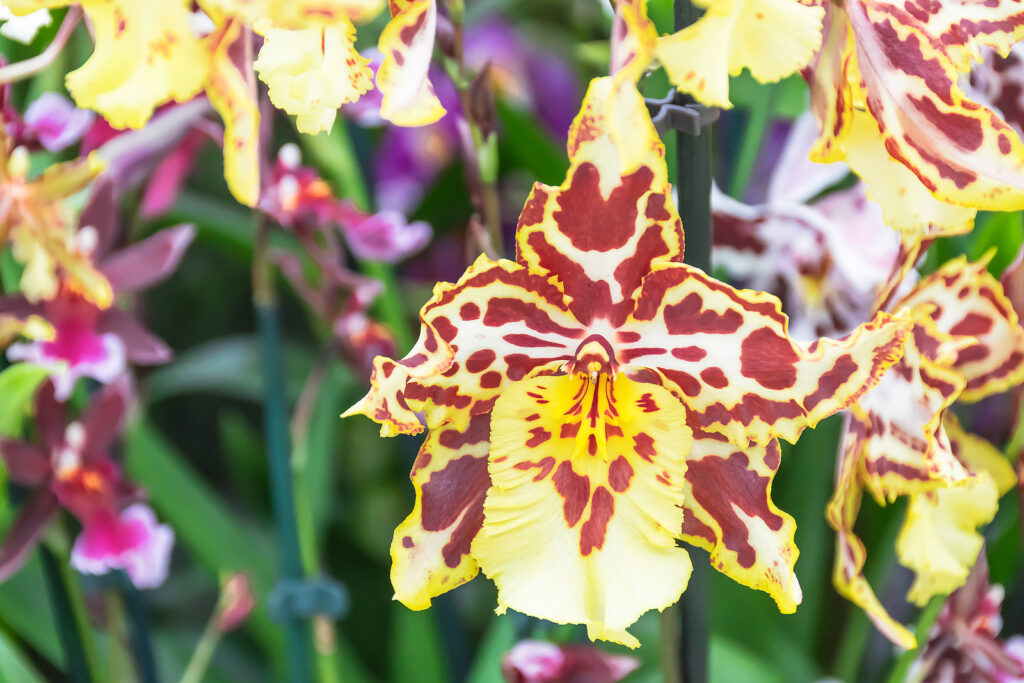
Odontoglossum
Odontoglossum are mostly epiphytic orchids native to tropical America. There are about 150 species in the genus. Odontoglossum are cultivated for their showy long-lasting flowers and are considered fairly easy to grow. The flowers have ruffled sepals and vary greatly in color and marking. Flowers are borne on a spike that arises from the base of the pseudobulbs. See How to Grow Odontoglossum
- Size: Ontoglossum grow 10 to 40 inches tall.
- Flowers and foliage: Odontoglossum has ruffled flowers, usually white, yellow, brown, or pink. Flowers are 1.5 to 4.5 inches acroos; 5 to 35 flowers per stem. Flowers last for 21 to 42 days. Small leathery leave sheath its flat, oval pseudobulbs; two or more leaves push up from the top of the bulb. Odontoglossum blooms best when crowded or potbound.
- Soil: Grow Odontoglossum in osmunda fiber or orchid bark mix.
- Light indoors: Give Odontoglossum bright light from southern exposure, but protect it from direct sun. Small plants to do well under artificial light, needing 12 to 16 light-hours daily.
- Temperarture: Keep Odontoglossum as cool as possible during the summer—preferably 60° to 70°F (16° to 21°C), never warmer than 80°F (27°C). Keep Odontoglossum cool in winter: night 45° to 55°F (7° to 13°C), day 60° to 65°F (16° to 18°C). Best in a cool to intermediate greenhouse.
- Water: Give Odontoglossum plenty of moisture throughout the year; allow the mediun to dry slightly between waterings. Boost the humidity by daily misting and by placing the pot on a humidity tray.
- Feeding: Feed Ondontoglossum with an all-purpose fertizer while in active growth. Plants in osmunda fiber require montly feedlings; plants in orchid bark mix need feeding every 3 weeks.

Oncidium — Butterfly orchid
Oncidium are epiphytic orchids native tropical America. Oncidium is a genus of about 300 species. Oncidium flowers are often yellow or brown and are commonly borne on spikes or in long sprays. Oncidium species are known variously as bee orchids, tiger orchids, butterfly orchids, and dancing ladies because of their appearance. Like many orchids, once Oncidium adjusts to their home, they are not difficult to grow. See How to Grow Oncidium
- Size: Oncidium grow 20 to 40 inches (50-101cm) tall.
- Flowers and foliage: Oncidium flowers are 1 to 3 inches (2.5-7.6cm) across; 10 to 100 flowers per stems; flowers bloom for 21 to 42 days. Some Oncidiums have small flowers; others display large blooms. Oncidium usually produce compressed pseudobulbs with leathery leaves; the foliage appears pencil-like in some types.
- Soil: Plant Oncidium in an all-purpose orchid mix with good drainage.
- Light indoors: Give Oncidium at least 3 to 4 hours of bright light daily from a southern or western exposure filtered (as through a sheer curtain). Oncidium does well under artificial light, needing 14 light-hours daily.
- Temperarture: Optimal average temperatures: day 65° to 75°F (18° to 24°C), night 55° to 60°F (13° to 16°C), or in a cool to intermediate greenhouse.
- Water: For most of the year, keep the soil constantly moist (like a squeezed-out sponge), but not soggy. Reduce water for several weeks following the completion of new growth, letting the soil dry out somewhat. Oncidium prefers high humidity.
- Feeding: Fertilize Oncidium every 2 or 3 weeks with a mild liquid ferlizer.
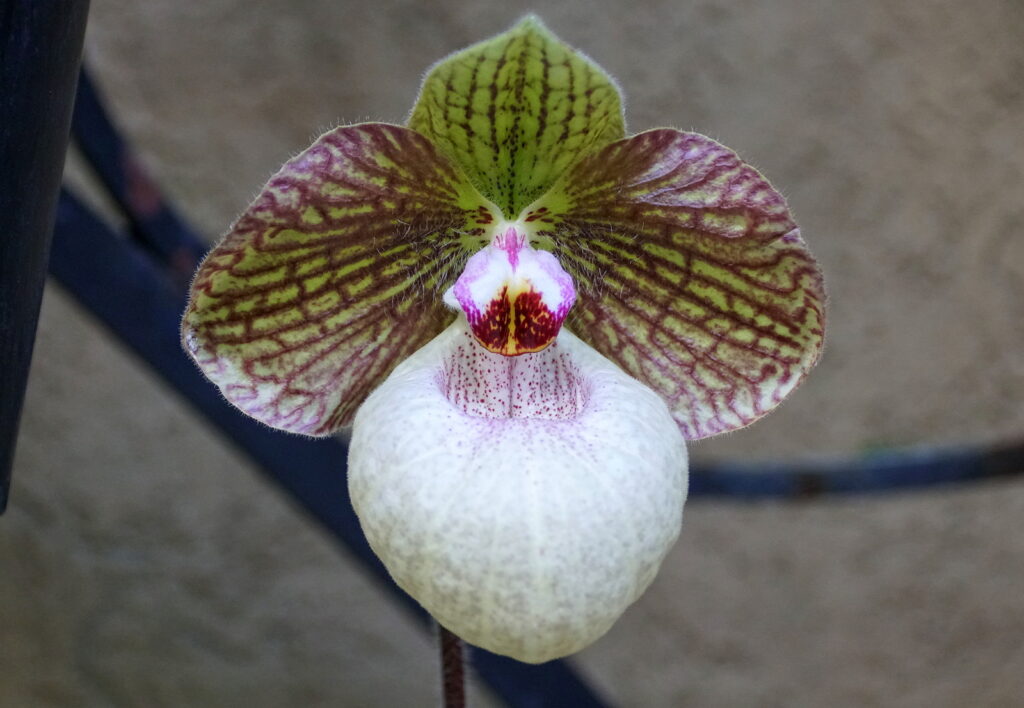
Paphiopedilum — Lady’s slipper
Paphiopedilum is a genus of about 70 tropical Asian orchids commonly known as lady’s slippers or slipper orchids because of their unique pouch.Paphiopedilumare terrestrial orhids. Many hybrids have been developed. Paphiopedilum have large waxy flowers of various colors and mottled or greenish leathery-textured leaves. Paphiopedilum are easily grown as houseplants; their care is very similar to African Violets. See How to Grow Paphiopedilum
- Size: Paphiopedium grows 10 to 20 inches (25-50cm) tall.
- Flowers and foliage: The flowers of some types are so shiny as though lacquered. Colors include white, yellow and green, marked with beige, mahogany, maroon, green, or white. Flowers are 3 to 6 inches (7.6-15cm) across; 1 to 2 flowers per stem; flowers last 21 to 42 days. Pahiopedilum have gracefully arching leaves; leaf color differs according to the plant’s blooming season. Paphiopedilums with plain green foliage usually bloom in winter; those with mottled leaves bloom in summer. Paphiopedilum thrives when roots are crowded.
- Soil: Grow Paphioedilum in osmunda fiber or finely chopped bark.
- Light indoors: Paphiopedilum prefers bright difused light from a northern or eastern exposure (but no direct sun). Paphiopedlium does well under artificial light, needing 12 light-hours daily.
- Temperarture: Mottled-leaf varieties need day temperatures of 70° to 80°F (21° to 27°C), night temperatures of 60° to 65°F (16° to 18°C). Solid green leafed varieties need day temperatures of 65° to 75°F (18° to 24°C), night temperatures of 55° to 60°F (13° to 16°C) or grow in an intermediate to warm greenhouse.
- Water: Paphiopedilum has no real rest period; keep the soil moist (like a squeezed-out sponge) at all times, but not soggy. Give the Paphiopedilum average humidity (use a humidity tray), and good air circulation.
- Feeding: Paphiopedilum is sensitive to fertilizers. If your plant is growing in fir bark, apply a liquid fertilizer, diluted to half strength, monthly during spring and summer; don’t fertilize at all during autumn and winter.
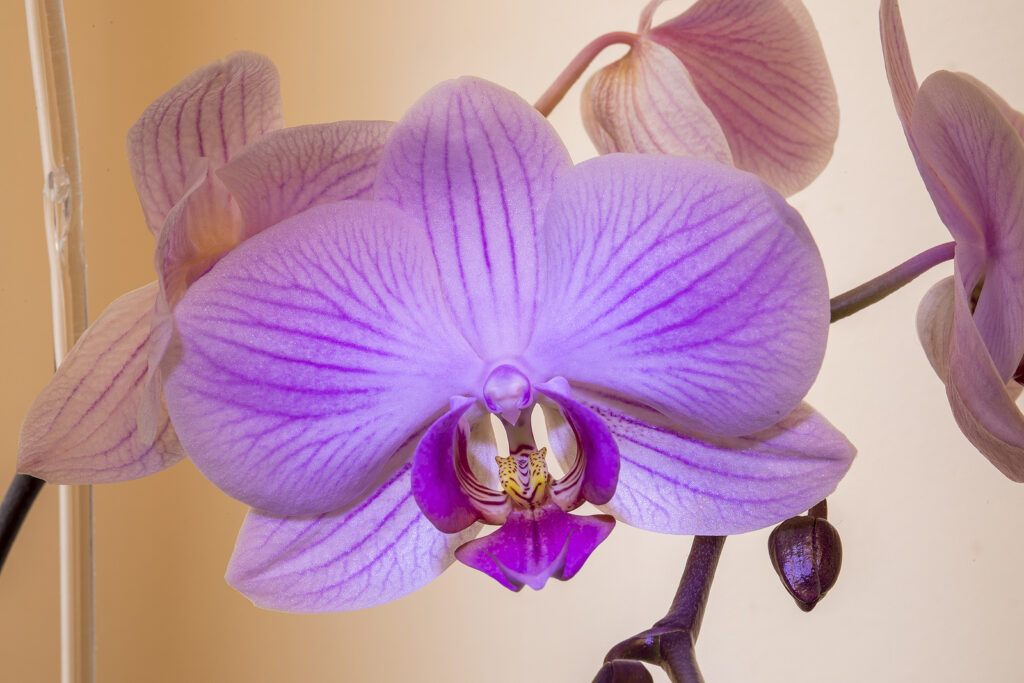
Phalaenopsis — Moth orchid
Phalaenopsis is a genus of about 60 species of orchids native to southeastern Asia and part of Australia. Phalaenopsis are epiphytic orchids nicknamed moth orchids. Phalaenopsis have beautiful white, purple, and pink flowers. Many of the horticultural species and hybrids are fairly easy to grow and are popular houseplants. See How to Grow Phalaenopsis
- Size: Phalaenopsis grows 10 to 30 inches (35-76cm) tall.
- Flowers and foliage: Phalaenopsis have white, pink, yellow, or multicolored flowers. Flower are 2 to 5 inches (5-12cm) across. Two to 40 flowers bloom in succession on each stem; flowers last 21 to 100 days. Flowers look like large moths, inspire its common name. Some small hybrids are available. Phalaenopsis have thick, broad and leathery leaves that emerge directly from the soil (the plant has no pseudobulbs).
- Soil: Plant Phalaenopsis in fir bark mixed with chopped tree fern fiber.
- Light indoors: Phalaenopsis likes bright light from northern or easetrer ex[psoure; shade from direct sun at midday (as through a sheer curtain); keep it out of direct sun. Phalaenopsis does well under artificial light, needing 12 to 16 hours daily.
- Temperarture: It prefers warm temperatures (75° to 80°F/24° to 27°C, never lower than 60°F/16°C), and high humidity.
- Water: All year, keep the soil moist (like a squeezed-out sponge), but not soggy. Use a humidity tray. Optimal humidity is 50% to 70%.
- Feeding: Give Phalaenopsis a proporional feeds of all-purpose fertilizer with each watering as directe on orchid fertilizer label.
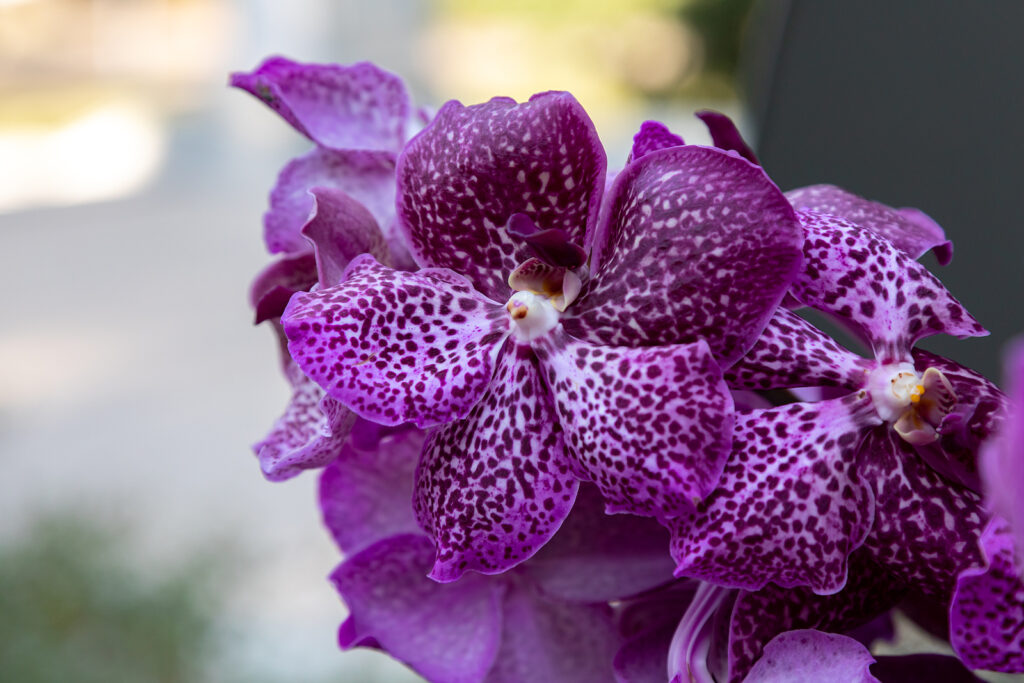
Vanda
Vanda is a genus of colorful orchids native to the Philippines, Malaysia, and the Himalayas. Most species are epiphytic and have long sturdy stems. Vanda flowers are usually flat and have a short spur on the lip; the flowers are long-lasting and often fragrant. Vanda grows well in warm temperatures with high humidity and requires a well-draining potting medium. See How to Grow Vanda
- Size: Vanda grows 15 to 40 inches (38-101cm) tall.
- Flowers and foliage: Beautiful open-faced flowers bloom in clusters atop long stems. Flowers appear in shades of rose with tinges of white and yellow, and bloom from spring through summer. Flowers are 2 to 4½ inches (2.5-11cm) across; 10 to 20 flowers per stem. Flowers last 21 to 42 days. To bloom properly, some Vanda need a winter rest and lots of bright reflected light. Vanda produces more leaves than most orchids; they are strap-like and arranged opposite one another.
- Soil: Plant Vanda in osmunda fiber or orchid bark mix. Vanda requires excellent drainage.
- Light indoors: Vanda needs plenty of bright filtered from a southern or western exposure (as through a sheer curtain) or reflected light, especially from autumn through late winter (to help set its flower buds).
- Temperarture: Vanda likes warm temperatures, 70° to 80°F (21°-27°C) in the day, never below 60°F (16°C) at night, or grow in in an intermediate to warm greenhouse.
- Water: Keep the medium evenly moist, never allow the medium to dry out. Mist aerial roots frequently. Water Vanda lightly during these winter months. During the rest of the year, Vanda appreciates plenty of water, good air circulation, and high humidity; grow your plant on a humidity tray.
- Feeding: During the growing season, apply a liquid fertilizer diluted to one-quarter strength, once a month.
Also of interest:















